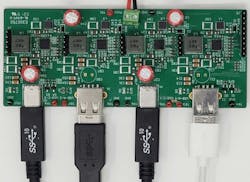Qorvo USB Fast Charger Powers Mobile Devices in Vehicles
The proliferation of connected-car devices with advanced in-cabin infotainment systems demands more power ports at higher power levels. Increasingly, these applications are adopting USB Type-C ports because they’re universal and capable of delivering the necessary power.
The latest addition to Qorvo’s portfolio of products for rapid in-vehicle charging of phones, tablets, and laptops, designated ACT4751M, is an automotive-grade, programmable voltage regulator with bias supply rails for microcontrollers or USB PD controllers. According to the company, the power-management IC (PMIC) is the industry's first AEC-Q100-qualified step-down, voltage-regulator IC dedicated to USB Type-C Fast Charger applications.
By way of review, a step-down charger provides protection between the power source and the device to mediate differences in the voltage source and the battery being charged. AEC-Q100 is an industry-standard specification established by the Automotive Electronics Council (AEC). In addition to its AEC-Q100 qualification, the ACT4751M meets the automotive EMI standard CISPR 25 Class 3.
Qorvo’s ACT4751M supports a wide input voltage range from 4.5 to 40 V and uses a synchronous step-down (buck) dc-dc architecture. It integrates both the high- and low-side MOSFETS. These 50-mΩ on-resistance transistors enable high efficiency to reduce power losses.
The ACT4751M integrates both the power and analog functions into a single power IC. This approach creates a complete USB Fast Charger solution when combined with a power-delivery controller, reducing development time and BOM cost.
The product's main buck converter can be dynamically programed to an output voltage between 3 and 24 V in 12.5-mV steps via the I2C interface or analog feedback. It also can dynamically program output current between 0 and 4 A in 256 steps via the I2C interface in a constant-current (CC) operation mode. The main buck supports external clock syncing for switching frequencies between 450 kHz and 2.25 MHz with features including an out-of-AM radio frequency and spread-spectrum operation.
The PMIC integrates a 5-V/350-mA mini-buck converter and a 20-mA AUX LDO of 0.9 to 4.0 V to simplify application system designs. These rails can power up a controller and the 1.5-W VCONN line in active USB-C cables.
The part comes in an AEC-Q100-grade, step-cut, side-wall-plating, 32-pin, 5- × 5-mm QFN package with a power-optimized footprint and exposed pad for improved thermal performance.
David Briggs, senior director of Qorvo's Programmable Power Management business, characterized Qorvo's ACT4751M as “a unique and easy-to-use step-down product that features the smallest size and highest efficiency on the market." Unlike competitive converter products, Briggs noted, the self-contained ACT4751M operates up to 40 V and has protection features—including UVLO, overvoltage input voltage lockout, OVP, UVP (Hiccup/Latch-off), OCP, and TSD protection—that withstand up to 48 V of load-dump events in a demanding automotive environment.
The ACT4751M meets all power requirements for USB Fast Charger applications, including the Power Delivery 3.0 Programmable Power Supply (USB PD 3.0 PPS) specification.
Qorvo's automotive power-management product family supports faster design certification and helps shorten time-to-market by offering multiple reference designs certified for USB Fast Chargers and Qualcomm Quick Charge 3.0 Quick Charge 4 and Quick Charge 4+ These designs are fully optimized to minimize size while delivering power-conversion efficiency.

